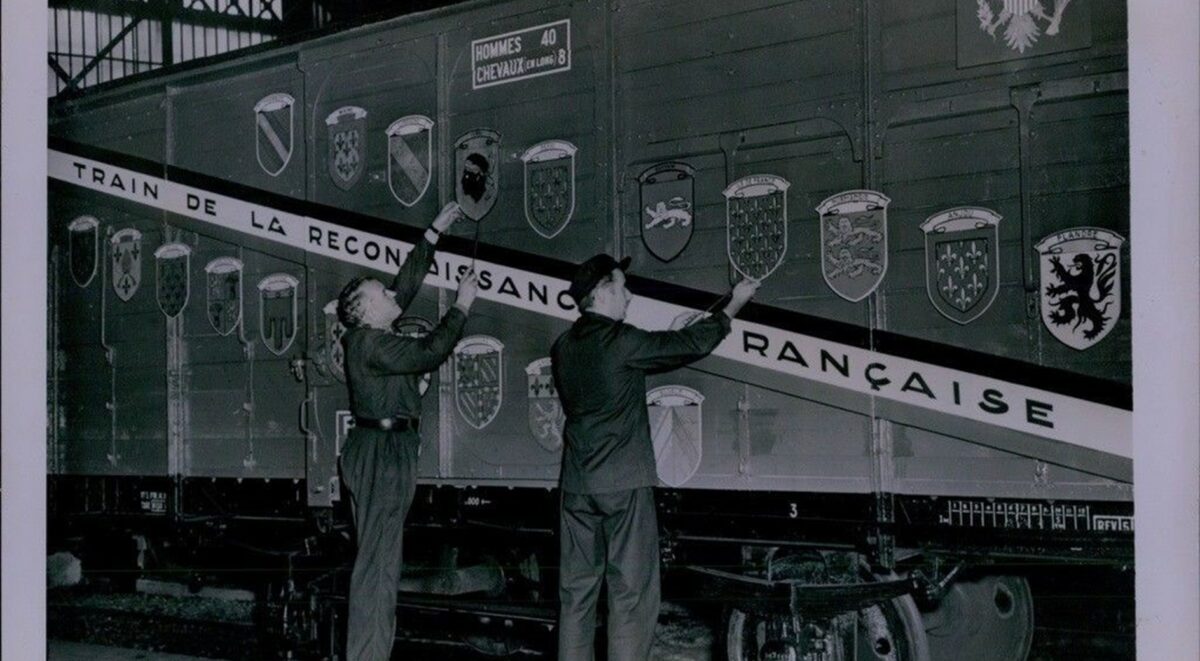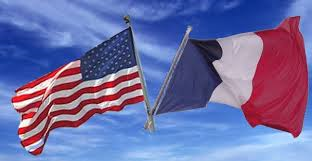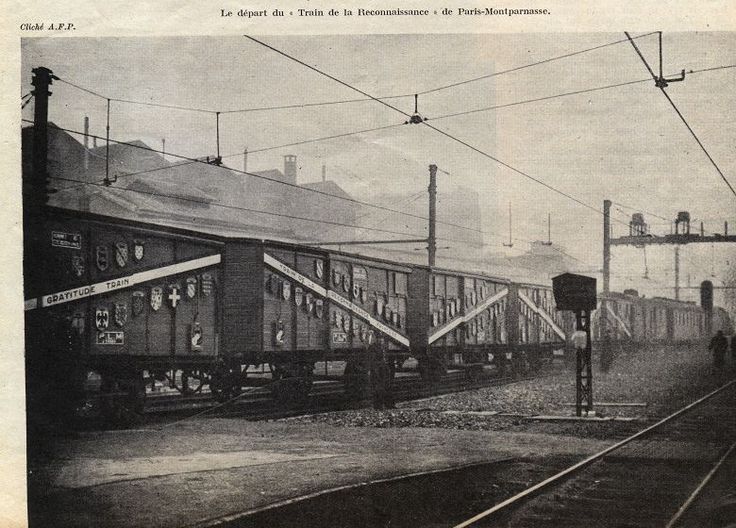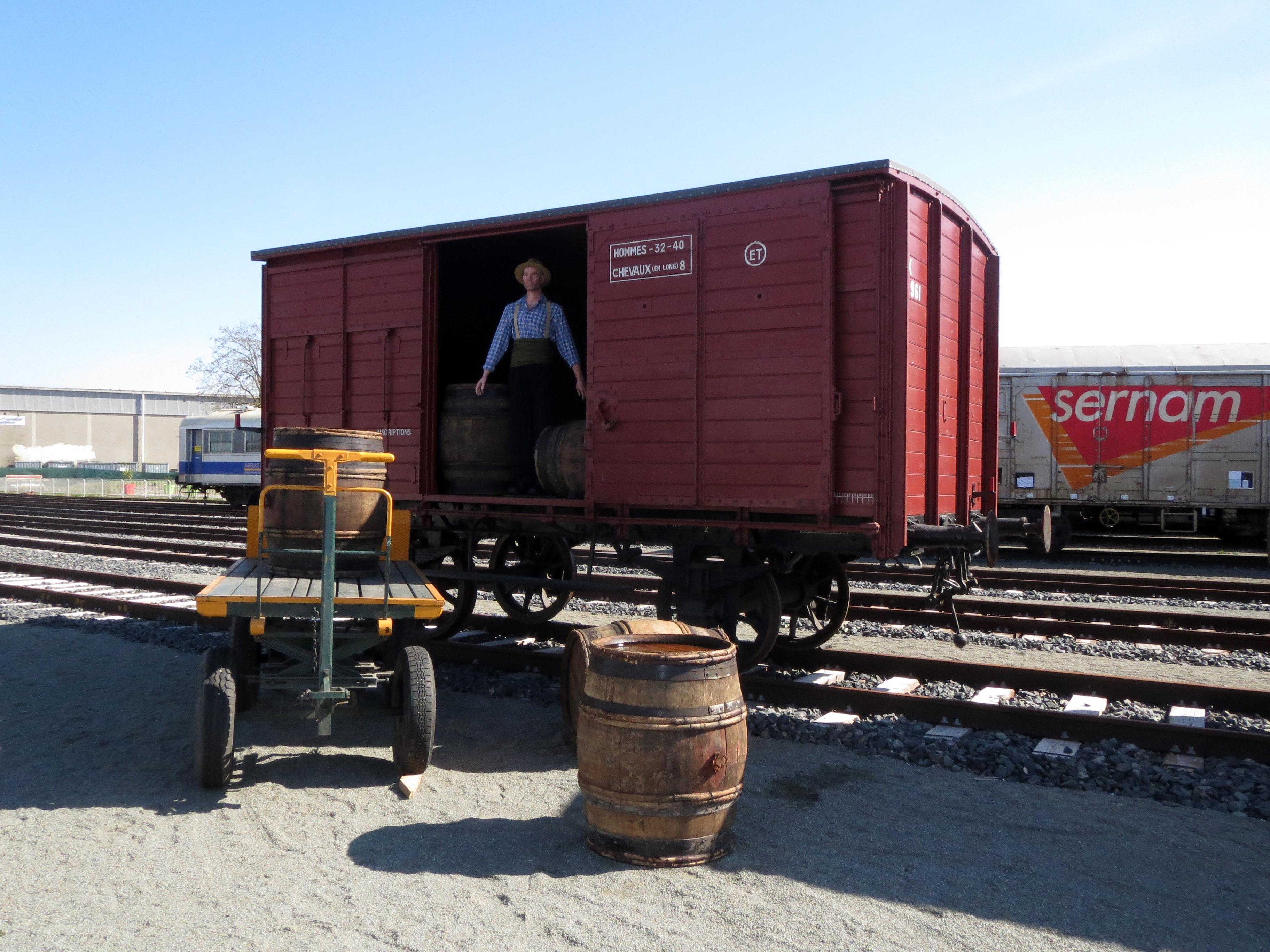
Paris, France, Monday, October 18, 1948: Shown above at the Gare Saint-Lazare, one of the French capital’s main train stations, are two SNCF workmen putting the finishing touches on one of the forty-nine “Merci Train” WWI boxcars of the “Hommes 40, Chevaux (en long) 8” type, before being sent to the United States. Photo by René Hélier for INS. Courtesy of Elisabeth Jenssen Private Collection. All rights reserved.

The « Train de la Reconnaissance Française » aka « Merci Train » (1949).
#GRATITUDE
#RESISTANCE
#FREEDOMOFTHEPRESS
#MDFDEFriendshipMerciTrain75
© The Official French-American Project entirely conceived by Ms. Elisabeth JENSSEN to celebrate the 75th Anniversary of the “Merci Train” (1949-2024). All rights reserved.
Chair: Elisabeth Jenssen
Honorary President: The Comte Gilbert de Pusy La Fayette
Contact: elisabeth.jenssen@francaisdeletranger.org

OTD: February 20, 1949 – February 20, 2024
The “Merci Train” was leaving Los Angeles, en route to Oakland, San Francisco, and Sacramento, California.
Dear MDFDE Friends of the “Merci Train,”
I hope you enjoyed our post MDFDE/FRANCE-USA: 75TH ANNIVERSARY OF THE “MERCI TRAIN:” THE FRENCH RESPONSE TO DREW PEARSON’S FRIENDSHIP TRAIN focusing on the real story of the DC/Hawaii Merci Train Boxcar currently undergoing renovation thanks to our hard-working friend Jeff LIVINGSTON, Project Mgr., and his Team of volunteers at the Hawaiian Railway Society (HRS).
Now that you found out how Hawaii got its own “Merci Train” Boxcar in 1949 — thanks to the late veteran journalist Drew PEARSON — it’s time for me to tackle another “myth,” another “unsolved mystery” up to now about the “Merci Train.” It has to do with the “actual age” of those 49 antique SNCF P.L.M “40 and 8” boxcars, our very own “French Railroad Ambassadors of French-American Friendship,” which we, the MDFDE/Friends of the Merci Train FRANCE-USA love so much, and whose legacy we must preserve especially for the new generation of American and French citizens, next in line to protect Human Rights and Democracy.
HOW OLD really are the remaining 43 (out of 49) SNCF “Merci Train” “40 and 8” (“Hommes 40, Chevaux (en long) 8”) WWI boxcars donated by the people of France to the people of the United States? When and where were they manufactured?
This is a key question. So please take a good, long look at the picture dated October 18, 1948 I posted (above), and featuring the SNCF P.L.M “40 and 8” boxcar (J number, alas, not showing as hidden by the SNCF workman).
Now, please check this second photo (below) dated January 6, 1949 marking the departure of the SNCF “French Gratitude Train” aka the “Merci Train,” with its 49 “lookalike” boxcars, all painted in slate grey, perfectly the same or just about in size and appearance, from the Gare Montparnasse in Paris, France, en route to the city-port of Le Havre.

January 6, 1949: The “Merci Train” leaving the Gare Montparnasse in Paris, France. Photo A.F.P.
In the earliest days of our official research (Winter 2016) in cooperation with the SNCF archivists and engineers, one of the first things I noticed (and couldn’t then figure out) was the obvious confusion in the U.S. about the actual age of the 49 SNCF “Merci Train” “40 and 8” boxcars.
Generally described as WWI era boxcars (1914-1918) — which transported the French troops to the First Battle of the Marne, to Verdun and, by April 1917, Gen. PERSHING‘s American Expeditionary Forces — the legendary Doughboys fighting on the western front as part of the Meuse-Argonne Offensive — to the killing fields of Saint-Mihiel, how could anyone claim the said boxcars were manufactured in France as far back as 1868? 1872? 1885?
Some even said these 49 French Boxcars were not French at all, they were actually made in the good old U.S.A., precisely in Pennsylvania. Really?
Sorry but NO. This is untrue and please let me tell you why.
First of all, while I understand how some people might have drawn this conclusion by the fact they may have found some indication — such as the name of a French factory together with a date — inscribed on the metal parts of the “Merci Train” Boxcar given to their State…
You don’t have to be an expert on the SNCF “French boxcars” to notice — just by looking at these antique 43 “Merci Train” boxcars still existing today in every corner of the United States — which all have been repaired, repainted, renovated at some point in the past 75 years thanks to their devoted American caretakers — the fairly “good shape” they are still in today.
You don’t have to be an expert on the SNCF “French boxcars” to, at least, have serious doubts in believing that — from 1868 or so to 1948 — for about 80 years before André PICARD and Commander Guy de la VASSELAIS organized the “Merci Train” in direct response to Drew PEARSON‘s Friendship Train, the SNCF boxcars would have survived that many years of “hard labor,” enduring many long wars, cargo activity etc…
The reality is that by 1948, of the very limited number* of the first French boxcars originally made in 1868 (and the late 19th century in France and Belgium), fewer (if any) could still be accounted for.
Furthermore, by the time, May 1948, André PICARD and his team were frantically looking in the various SNCF hangars for 48 boxcars in good enough shape to be shipped to the United States, then a 49th boxcar for Washington D.C., thanks to U.S. Ambassador Jefferson CAFFERY, to form the “Merci Train” ASAP, the French were in a big hurry since the initial departure of the “Merci Train” from Le Havre was scheduled for November 25, 1948.
Indeed, the National Federation of French Railroad War Veterans and the Union Française didn’t have the time, didn’t have the funds to repair any 80-year old boxcar still around which would have been so damaged it would most certainly need lots of work and/or rebuilding.
So by 2017 – 2018, at this stage of my work, it was already clear to me that the original 49 SNCF P.L.M “40 and 8” boxcars André PICARD was finally able to locate nationwide — despite the severe post-WWII shortage of boxcars and all railroad equipments and parts — and bring to the SNCF repair shops in and near Paris (another huge task to accomplish) — where the bowcars were “simply” refurbished and got an extra coat of paint before being decorated — as well documented — indeed these 49 French WWI era boxcars were, well… from the 1910s.
But since this is serious, unprecedented research in the name of my late French grandfather, WWI railroad veteran, and my dear friend Gabrielle GRISWOLD, our memory curator of the Friendship Train, the MDFDE having the duty to correct well-spread misinformation and false claims about the Friendship and Merci Trains, I had to get the story straight once and for all.
In that spirit, to be ABSOLUTELY SURE, on top of the SNCF archivists and engineers I had already consulted with, I went to the supreme RAILROAD EXPERTS, starting with M. Philippe MIRVILLE, President of the SNCF Cité du Train in Mulhouse, France (2006 to 2020).
And that’s when everything started to really make sense! Still a little bit confused about the REAL age of the Merci Train boxcars? How about if we showed you an actual picture of an 1868 French boxcar, the only one left in France and almost surely worldwide, so you can compare it with the “Merci Train” boxcars? Great, here we go!
THANKS TO M. PHILIPPE MIRVILLE…
Introducing the 1st generation, the “Mother of all French 40 & 8 boxcars,” the oldest covered “40 & 8” boxcar in France, compliments of the Cité du Train (the SNCF Railway Museum) in Mulhouse, France.

Covered Wagon, standard gauge, K132961 from the P.L.M Company 1st generation of the 40 & 8 boxcars dating from 1868. © Philippe MIRVILLE La Cité du Train (SNCF Railroad Museum) in Mulhouse, France.
And here is its full description and additional information I received from M. Philippe Mirville:
The covered wagon to transport everything safely!
1868
Covered Wagon, standard gauge, K132961 P.L.M – series of 88 wagons K 132 951 to 133 039.
PLM Company.
Different types of wagons to transport all types of goods
By the end of the 19th century, the railway had more than 50 years of experience. It now transports practically all goods throughout the national territory through the various railway companies. To ensure this transport, several types of wagons were built. In the standard type wagons, there are boxcars used mainly for goods that are afraid of bad weather, heat or humidity, gondola cars with open bodies at the top, and flat cars that are often simple platforms. For particular transports, there are specialized specialized cars, which are very often owned by companies and not by the railways, to allow them to transport their own goods, such as refrigerated cars, low-loaders or tank cars. Until the end of the 19th century, these wagons were simply equipped with two axles. Later, some were equipped with bogies to accept heavier and heavier loads.
Towards the end of the 19th century all railway companies equipped themselves with “covered” type freight wagons allowing them to transport all kinds of goods as long as they could enter through the side door.
The wagon presented (here at the Cité du Train) was built in 1868 for the Compagnie du P.L.M. Paris-Lyon-Méditerranée. This type of wagon, built in 3,462 units in several series, is mounted on two axles and equipped with a central door on each side and 4 opening shutters allowing interior ventilation depending on transport. This type of wagon was built until 1870. Having been designed before the end of the 19th century, it was not equipped with a brake system.
AND LAST BUT NOT LEAST, THANKS TO DR. CLIVE LAMMING…
THE WORLD’s expert, our own Dr. Clive LAMMING, the historian with a PhD in railroad history, author of more than 120 books on railways, who has worked on so many big projects worldwide during his long career, including serving as technical and historical adviser for genius American Director Martin SCORSESE’s movie Hugo Cabret, which included recreating the Gare du Nord in Paris, France, filmed at the Shepperton Studios in London, U.K. (2011). And most recently, working in the same capacity for Murder on the Orient Express, an American mystery drama film by British actor and director Kenneth Branagh, produced by 20th Century Fox (2017) .
And here is what Dr. Clive LAMMING has to say about the 49 “Merci Train” SNCF P.L.M boxcars starting with:
The inscription “Hommes 40 – Chevaux 8” (“Men 40 – Horses 8”): This inscription has nothing to do with the two World Wars. It appeared on covered wagons following the war of 1870 as part of the “next” (war), and following the disastrous experience of the Franco-Prussian war with a French Army which knew nothing about the strategic use of railways. The said inscription was a marking for wagons suitable for use in the concentration of troops on the front, and the wagons which bore it were, after the Second World War, of a very old and completely outdated type.
No doubt it was these very old wagons that were used for the “Gratitude train” (“Merci Train”) because, for the most part, they could no longer serve, run in France, and in the USA they would not have been able to run because of differences in rolling and coupling standards, and they have never been driven in the USA, being presented on wagon trucks during ceremonies.
France, in the aftermath of the war, was sorely short of wagons and was not going to part with wagons in running condition to send them to the USA knowing that they would probably not return. These wagons were, in a way, lost packaging… but very useful, very spectacular, and they made an impression, playing their part.
These wagons are covered wagons of the old networks before 1938 (the year of the creation of the SNCF which replaced the old networks) and of a very common type, and not only on the PLM network. Built between 1904 and 1910, there were many of them at the time and they represented a national standardised type. The wagons of the Office Central des Etudes du Matériel (OCEM) of 1919 and 1929, which were longer and technically better, particularly for braking, replaced them on all the networks and were used to improve the number of wagons.
So now please take a final look at the said three pictures (above). Do you think Dr. LAMMING is 100% “on the right track” in declaring — without a doubt — that the 49 “Merci Train” SNCF P.L.M boxcars were actually 114 – 120-year old French boxcars? Because if you do, you are also 100% correct!
SO OUR WARMEST CONGRATULATIONS TO:
ALABAMA – ARIZONA – ARKANSAS – CALIFORNIA – DELAWARE – FLORIDA – GEORGIA – HAWAII – IDAHO – INDIANA – IOWA – KANSAS – KENTUCKY – LOUISIANA – MAINE – MARYLAND – MICHIGAN – MINNESOTA – MISSISSIPI – MISSOURI – MONTANA – NEVADA – NEW HAMPSHIRE – NEW JERSEY – NEW MEXICO – NEW YORK – NORTH CAROLINA – NORTH DAKOTA – OHIO – OKLAHOMA – OREGON – PENNSYLVANIA – RHODE ISLAND – SOUTH CAROLINA – SOUTH DAKOTA – TENNESSEE – TEXAS – UTAH – VERMONT – VIRGINIA – WEST VIRGINIA – WISCONSIN – WYOMING.
FOR BEING THE PROUD CARETAKER OF YOUR OWN ANTIQUE 114 – 120-YEAR OLD SNCF “MERCI TRAIN” “40 AND 8” WWI ERA BOXCAR!
In this very special year marking the 75th Anniversary of the “Merci Train,” the MDFDE Friends of the Merci Train FRANCE-USA is sending 700 more wagons of Friendship, 700 French boxcars filled to the top with heartfelt “MERCIS” to each of the 43 States for taking such a good care and for so long of your respective antique “Merci Train” boxcar.
And to the other six States:
COLORADO – CONNECTICUT – ILLINOIS – NEW JERSEY – NEBRASKA – MASSACHUSETTS
– which, alas, had lost long ago their own “Merci Train” boxcar, we also send 700 wagons of heartfelt “MERCIS” for preserving with such pride some of the gifts and archives they had received, 75 years ago, from the grateful People of France.
For more exciting real info. on the “Merci Train,” please feel free to join the MDFDE via our brand new FB Page Friends of the Merci Train FRANCE-USA:
https://www.facebook.com/groups/700330968840425
And on Twitter: @JElisabeth53901
All the best,
Elisabeth Jenssen
P. S. And next time you travel to Western Europe, please go visit the wonderful Cité du Train (SNCF Railroad Museum) in Mulhouse, located 25 minutes from Basel (Switzerland) and 30 minutes from Freiburg (Germany). Please tell them the MDFDE-Friends of the Merci Train FRANCE-USA is sending you…
Here is the address:
Cité du Train (Cité du Train – Patrimoine SNCF) 2 rue Alfred de Glehn 68200 Mulhouse FRANCE Phone: From the States: 011 3 89 42 83 33 Email: message@citedutrain.com Cité du Train – Patrimoine SNCF | Musée | Mulhouse | Alsace (citedutrain.com)
Related Posts:
MDFDE/France-USA: Dr. Clive LAMMING Joins Our Executive Committee #MDFDEFriendshipMerciTrain70
La locomotive « Pershing » et les wagons TP : les USA en France pour la bonne cause.